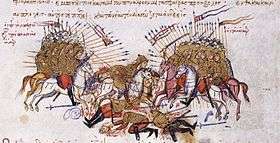Vestiaritai
 | |
| This article is part of the series on the military of the Byzantine Empire, 330–1453 AD | |
| Structural history | |
|---|---|
| Byzantine army: East Roman army, Middle Byzantine army (themes • tagmata • Hetaireia), Komnenian-era army (pronoia), Palaiologan-era army (allagia) • Varangian Guard • Generals (Magister militum • Domestic of the Schools • Grand Domestic • Protostrator) | |
| Byzantine navy: Greek fire • Dromon • Admirals (Droungarios of the Fleet • Megas doux) | |
| Campaign history | |
| Lists of wars, revolts and civil wars, and battles | |
| Strategy and tactics | |
| Tactics • Siege warfare • Military manuals • Fortifications (Walls of Constantinople) | |
The Vestiaritai (Greek: βεστιαρῖται, singular: βεστιαρίτης) were a corps of imperial bodyguards and fiscal officials in the Byzantine Empire, attested from the 11th to the 15th centuries.
History and functions
The vestiaritai appear in the mid-11th century, with the first known vestiaritēs, John Iberitzes, attested in 1049.[1] As their name indicates, they had a connection to the imperial wardrobe and treasury, the vestiarion, probably initially raised as a guard detachment for it. From circa 1080 on, they were formally distinguished into two groups: the "inner" or "household" vestiaritai (esō or oikeioi vestiaritai), attached to the emperor's private treasury (the esō/oikeiakon vestiarion) under a megas primikērios, and the "outer" (exō vestiaritai) under a primikērios, who were probably under the public or state treasury (basilikon vestiarion).[2] Gradually, they replaced various other groups of armed guards that the Byzantine emperors had employed inside Constantinople itself, such as the manglabitai or the pantheōtai, and became the exclusive corps of the emperor's confidential agents.[3] As the princess and historian Anna Komnene writes, they were the courtiers "closest" to the emperor.[1] With the military crisis of the 1070s, they were also formed into a regular palace guard regiment, serving alongside the Varangian Guard in the Komnenian-era army.[4]
The vestiaritai are attested as late as 1387, and likely continued to exist after.[1] In the 13th and 14th centuries, however, their role was chiefly fiscal: they were responsible for levying soldiers and wagons from the provinces, under the control of the domestikos of the themes of the East.[1][5] The chief of the vestiaritai was called prōtovestiaritēs (πρωτοβεστιαρίτης) in the 13th and 14th centuries (not to be confused with the much older and more important office of prōtovestiarios). The title is attested as late as 1451, when it was held by the historian George Sphrantzes.[6] In the mid-14th century Book of Offices of Pseudo-Kodinos, it ranks nineteenth in the order of precedence, following the parakoimōmenos of the bedchamber.[7] According to the same work, its insignia were: a wooden staff (dikanikion) with gold and red-gold knobs, a skiadion hat with embroidery of the klapotōn type, another type of hat called skaranikon of white and gold silk with gold-wire embroidery and images of the emperor in the front and back, and a silk robe of office or kabbadion.[8]
References
- 1 2 3 4 Kazhdan 1991, p. 2163.
- ↑ Oikonomides 1976, p. 130.
- ↑ Oikonomides 1976, p. 129.
- ↑ Bartusis 1997, p. 271; Oikonomides 1976, pp. 129–130.
- ↑ Guilland 1967, Tome I, p. 589.
- ↑ Kazhdan 1991, pp. 1750, 2163; Guilland 1967, Tome II, pp. 203–209.
- ↑ Verpeaux 1966, p. 137.
- ↑ Verpeaux 1966, p. 157.
Sources
- Bartusis, Mark C. (1997). The Late Byzantine Army: Arms and Society 1204–1453. Philadelphia, Pennsylvania: University of Pennsylvania Press. ISBN 0-8122-1620-2.
- Guilland, Rodolphe (1967). Recherches sur les Institutions Byzantines, Tomes I and II (in French). Berlin, Germany: Akademie-Verlag.
- Kazhdan, Alexander Petrovich, ed. (1991). The Oxford Dictionary of Byzantium. New York, New York and Oxford, United Kingdom: Oxford University Press. ISBN 978-0-19-504652-6.
- Oikonomides, Nicolas (1976). Travaux et Mémoires 6 (in French). Paris, France: E. de Boccard.
- Verpeaux, Jean, ed. (1966). Pseudo-Kodinos, Traité des Offices (in French). Paris, France: Éditions du Centre National de la Recherche Scientifique.